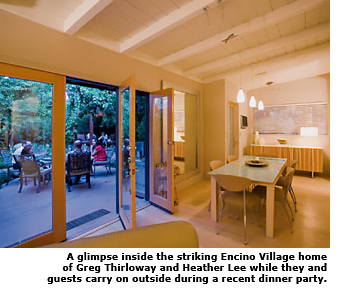The Modest Modern of Encino Village - Encino
 Modern architecture is often accused of being cold, austere, and unlivable. Fans of course don't buy it. But there is at least one attribute fans will agree on—modern architecture tends to be pure. If you ask a committed modern architect to design a Colonial home, or to incorporate shutters into a design, you can expect derisive laughter—or worse.
Modern architecture is often accused of being cold, austere, and unlivable. Fans of course don't buy it. But there is at least one attribute fans will agree on—modern architecture tends to be pure. If you ask a committed modern architect to design a Colonial home, or to incorporate shutters into a design, you can expect derisive laughter—or worse.
What can you say then about the charming San Fernando Valley enclave of Encino Village, in Encino, where low-gabled modern ranches sit alongside 'Colonials' that come with weathervanes?
It set folks to wondering.
"Lee and BJ and I were like, 'Hmmm.' The houses are so well done, the neighborhood is so well laid out. There must be more to the architecture than we know about," says Alegre Ramos, who with neighbors Lee Bothast and BJ Farrar set out to solve the mystery.
Their historical quest, which began six years ago, took them through cyberspace and to the city planning department, and had them calling the archives of the University of Nevada at Las Vegas—and it was productive.

"When I moved here six years ago, nobody had even heard of Martin Stern," says Bothast, a realtor and architect. Today Stern is admired throughout the 400-plus-home neighborhood for designing all of its homes—the 'moderns,' 'transitionals,' 'ranches,' and 'Colonials.'
The quest did something more. It spurred on many neighbors to take greater care of the neighborhood's very unique architectural heritage. More than modern tract developments that are modern through and through, Encino Village suggests the bureaucratic, aesthetic, and marketing battles that hindered the growth of modern suburbs in the postwar years.
Was Martin J. Stern, Jr., who designed the homes for the Marwill Corporation, a committed modernist? That's what resident Joshua Tunnick believes.
"From what I've seen of the bones of the house," says Tunnick, an architect who has been remodeling his home, "I think Stern designed a modern house and they said, 'Make it palatable to the masses.'"
Or could it be, as Farrar suggests, that the Federal Housing Administration preferred to help finance neighborhoods with "more-conservative models?"

Further research is clearly warranted. Stern (1917-2001), who won fame later in his career as a leading casino-hotel architect in Las Vegas (the MGM Grand), also made a mark early on in L.A. for designing the late and lamented Googie-style Ship's Coffee Shop restaurants. "They were my favorites! I loved them," says Adam Lombard, an Encino Villager who never dreamed he'd be living in a home designed by Ship's creator.
But even the modern homes in Encino Village have conservatism about them. Los Angeles preservationist Adriene Biondo calls them "modest modern." Most of the homes are a hybrid post-and-beam construction, mixing posts holding beams with standard stud construction. And the posts and beams are generally hidden behind siding, though they are, however, visible in many ceilings. The Colonials are standard stud construction.
"I don't think of this as pure modernist, or as anything close to it," says Eric Klusman, a newcomer to the neighborhood who knows modernism as the former owner of Gregory Ain's Hay house. "The Hay house is International Modern. That's never applied to this neighborhood. But this neighborhood has enough touches of modern so that it's interesting."
So much so, says Karen Hallberg, Eric's wife, that Encino Village is winning fame. "It's on the mid-century modern aficionado's radar."
Encino Village is well regarded throughout the valley, say Eddie Bernard, a broker who has handled hundreds of sales there for 27 years and has remodeled more than 15 neighborhood houses. "If you see my listings for homes in the neighborhood," he says, "you'll see 'prestigious' in there."\

With homes that range in original size from 1,260 to 1,533 square feet and with three original bedrooms (or four, if owners were willing to sacrifice their convertible 'den') and two-car garages, Bernard says, Encino Village always offered more than nearby neighborhoods. Encino Village was built in two phases between 1955 and 1957, with houses selling for $16,500 to $18,500, on what used to be RKO Studio's 'Encino Ranch.'




